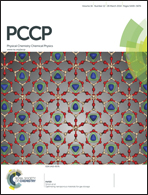Joint theoretical and experimental study on the phosphorescence of 2,2′-bithiophene†
Abstract
Theoretical investigation into vibronic activity observed in the phosphorescence spectrum of 2,2′-bithiophene (2T) has revealed unexpectedly large discrepancies between the theoretical predictions and the available experimental spectrum. Theoretical spectra, obtained using the results of the high-level quantum chemistry calculations and the well founded model for vibronic activity, are considerably wider than the experimental one. The energy of the onset (corresponding to the adiabatic transition energy) is quantitatively reproduced, but the centers of gravity of the simulated spectral bands (vertical emission energies) are considerably red-shifted with respect to experiment. Critical reconsideration and tests of the approximations underlying the theoretical approach have failed to pinpoint the source of the observed discrepancies. In the following experimental reinvestigation of the phosphorescence of 2T we have observed that unusually large concentration of the chromophore and careful recalibration of the detector prior to measurements have been essential to collect a good quality spectrum. Incidentally, being considerably different from the previously reported one, the newly reported phosphorescence spectrum of 2T is in nearly quantitative agreement with the theoretical predictions.


 Please wait while we load your content...
Please wait while we load your content...